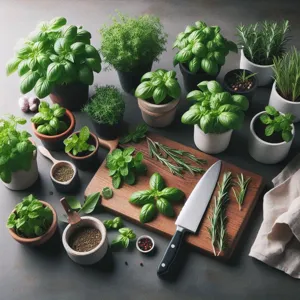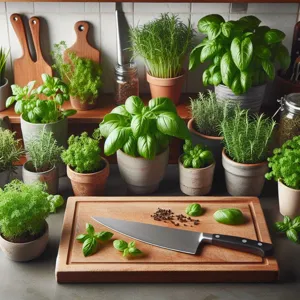In the heart of every home lies a treasure trove of pantry staples, waiting to be transformed into culinary masterpieces.
Often overlooked, these basic ingredients—such as rice, beans, pasta, and canned goods—hold the potential to elevate your cooking game and impress even the most discerning palates. With a splash of creativity and a dash of inspiration, you can turn everyday items into gourmet meals that tantalize the taste buds and bring joy to the dinner table. In this blog post, we’ll explore a variety of innovative culinary hacks that will not only enhance your cooking skills but also reignite your passion for home-cooked meals. Say goodbye to mundane dinners and hello to a world of flavor, as we unlock the secrets to transforming your pantry staples into extraordinary dishes that celebrate simplicity and creativity in the kitchen. Get ready to embark on a delicious journey that will forever change the way you view your pantry!
1. Introduction: Elevating Everyday Ingredients

In today’s fast-paced world, where gourmet dining seems reserved for special occasions or extravagant outings, the beauty of culinary creativity lies in the everyday pantry staples that often go unnoticed. Imagine transforming a simple can of chickpeas or a bag of frozen peas into a culinary masterpiece that tantalizes the taste buds and impresses the dinner guests. This blog seeks to unveil the magic that can happen when you elevate commonplace ingredients into gourmet meals, proving that you don’t need a Michelin star chef in the kitchen to create something extraordinary.
Every cook, from the novice to the seasoned gourmet, has faced the daunting question: “What should I make for dinner?” Often, the answer lies in the pantry. With a bit of imagination and some clever techniques, staples like rice, pasta, and canned goods can be reinvented into dishes that are not only delicious but also visually stunning. We’ll explore innovative methods such as flavor infusions, creative pairings, and unexpected presentations that highlight the potential of these humble ingredients.
In this blog post, we’ll dive into various culinary hacks that will inspire you to look beyond the ordinary. Whether you’re a busy professional looking to whip up something quick and satisfying or a home cook eager to impress with minimal effort, these tips will help you unlock the gourmet potential in your kitchen. So, gather your pantry staples, roll up your sleeves, and get ready to embark on a culinary adventure that turns the ordinary into the extraordinary!
2. Understanding Pantry Staples: What You Probably Already Have
Understanding pantry staples is the first step toward culinary creativity, and the good news is that you likely already have a treasure trove of potential gourmet ingredients sitting right in your kitchen. When we think of pantry staples, we often envision basic items like rice, pasta, canned tomatoes, and beans. However, these unassuming ingredients can serve as a blank canvas for your culinary masterpieces.
Take, for instance, a humble bag of rice. While it may seem basic, with a few strategic additions, you can transform it into a fragrant biryani, a creamy risotto, or even a refreshing rice salad bursting with seasonal vegetables and herbs. Similarly, a can of chickpeas can easily be elevated into a rich, spiced hummus or a hearty salad with roasted vegetables and a drizzle of tahini.
Don’t overlook the power of spices and herbs, which can elevate even the simplest of dishes. A dash of smoked paprika can add depth to roasted potatoes, while a sprinkle of fresh basil can brighten up a classic tomato sauce. Understanding how to combine these staple ingredients with flavorful seasonings can open up a world of culinary possibilities.
Moreover, think about what’s lurking in the back of your pantry. Those jars of preserved lemon? They can bring an unexpected brightness to a grain bowl. That half-empty bottle of soy sauce? It’s the secret ingredient for a quick stir-fry or a marinade that packs a punch.
By taking stock of what you already have, you can create a vibrant menu without the need for a lengthy grocery list. Embrace the creativity that comes with working with pantry staples, and you’ll soon find yourself whipping up gourmet meals that impress both your palate and your guests. So, take a moment to explore your pantry—it may just hold the keys to your next culinary adventure.
3. The Art of Flavor Pairing: Unexpected Combinations

In the world of culinary creativity, the art of flavor pairing stands out as a gateway to transforming simple pantry staples into gourmet meals. The magic lies in the unexpected combinations that can elevate ordinary ingredients into extraordinary dishes. Imagine taking a humble can of chickpeas, often overlooked in the pantry, and pairing it with bold flavors like smoky paprika and zesty lemon. The result? A vibrant, protein-packed hummus that dances on the palate and brings life to any meal.
Exploring flavor pairings is akin to embarking on a delicious adventure. Consider the classic marriage of sweet and savory: drizzling honey over roasted Brussels sprouts can create a caramelized masterpiece that tantalizes the taste buds. Or, how about the surprising pairing of chocolate with chili? A pinch of cayenne mixed into a rich chocolate sauce can add a thrilling kick that transforms a simple dessert into a showstopper.
Don’t shy away from experimenting with herbs and spices, either. A sprinkle of fresh basil on a bowl of pasta can elevate it to new heights, while a dash of cardamom in your morning oatmeal brings warmth and depth that’s both comforting and unexpected. The key is to think outside the box. Take inspiration from various cuisines—Asian ginger and garlic can breathe life into a Mediterranean dish, while Italian balsamic vinegar can add a tangy twist to a Thai-inspired salad.
As you delve into the world of flavor pairing, remember that the possibilities are endless. Keep an open mind and allow your palate to guide you. Your pantry is not just a collection of ingredients; it’s a canvas waiting for your culinary masterpiece. With a little creativity, you can transform everyday staples into gourmet experiences that delight and surprise. So, grab those unexpected combinations and let your kitchen become the stage for your next culinary triumph!
4. Transforming Rice: From Basic to Gourmet Risotto
Rice is a pantry staple that often gets a bad rap for being bland and boring, but with a few creative culinary hacks, you can elevate this humble grain into an indulgent gourmet dish—risotto. While traditional risotto may seem intimidating with its reputation for requiring constant stirring and precise timing, the truth is that anyone can master this creamy, comforting classic with a little finesse.
Start by choosing the right type of rice; Arborio, Carnaroli, or Vialone Nano are all ideal choices due to their high starch content, which is crucial for that signature creaminess. Begin by sautéing finely chopped onions or shallots in a drizzle of olive oil or a pat of butter until they become translucent and fragrant. This aromatic base sets the stage for a flavor-packed dish.
Next, toast the rice in the pan for a minute or two until it turns slightly translucent. This step might seem trivial, but it enhances the nutty flavor of the rice and adds depth to your dish. Once toasted, deglaze the pan with a splash of white wine, allowing the alcohol to cook off while the rice absorbs the flavorful essence.
Now for the magic of risotto: the gradual addition of warm broth. Start with a ladleful of homemade or store-bought chicken or vegetable broth, stirring gently and allowing the rice to absorb the liquid before adding more. This slow process releases the starches, resulting in a rich and creamy texture without the need for cream.
For an added gourmet touch, consider incorporating seasonal vegetables, sautéed mushrooms, or fresh herbs towards the end of cooking. A handful of peas or asparagus can add a pop of color and freshness, while a sprinkle of grated Parmesan cheese just before serving elevates the dish to new heights.
Finally, finish with a drizzle of high-quality olive oil or a pat of butter for a glossy sheen, and garnish with freshly chopped herbs or a zest of lemon to brighten the flavors. With just a little creativity and a few extra steps, you can transform plain rice into a luxurious risotto that impresses at any dinner table. Enjoy your culinary masterpiece—your pantry staples just achieved gourmet status!
5. Pasta Perfection: Quick Sauces Using Pantry Essentials

When it comes to quick and delicious meals, pasta is the ultimate canvas. With just a handful of pantry staples, you can whip up gourmet sauces that elevate your dish from mundane to magnificent in mere minutes. The beauty of pasta lies not only in its versatility but also in its ability to absorb flavors, making it the perfect vehicle for your culinary creativity.
Start with the classic garlic and olive oil sauce, a simple yet sophisticated option that requires just two key ingredients: minced garlic and high-quality olive oil. Sauté the garlic in a generous drizzle of olive oil until it turns golden and fragrant, then toss in your cooked pasta. Finish with a sprinkle of red pepper flakes, grated Parmesan, and a handful of fresh parsley for a vibrant, aromatic dish that feels indulgent without breaking a sweat.
For those craving something a bit creamier, a pantry staple like canned tomatoes can be transformed into a luscious marinara. Sauté onions and garlic in olive oil, add crushed tomatoes, and season with salt, pepper, and Italian herbs. Let it simmer while your pasta cooks, and you’ll have a rich, flavorful sauce that rivals any restaurant offering.
If you’re looking to incorporate more veggies, consider a quick pesto made from pantry essentials. Blend together your favorite nuts—almonds or walnuts work beautifully—with garlic, olive oil, and any leftover greens like spinach or kale. Toss this vibrant green sauce with freshly cooked pasta, and you’ll have a dish that’s not only delicious but packed with nutrients.
Lastly, don’t overlook the power of cheese! A simple cheese sauce can be made by melting butter and whisking in flour to create a roux, then gradually adding milk and your choice of cheese until you achieve a creamy consistency. Drizzle this decadent creation over your pasta for an instant comfort-food classic.
With these quick sauces made from pantry staples, you can turn any ordinary pasta night into an extraordinary culinary experience, proving that gourmet doesn’t always mean complicated. So next time you find yourself staring into your pantry, remember that magic is just a pot of boiling water away!
6. Creative Uses for Canned Goods: Beyond the Basics
Canned goods often get a bad rap, relegated to the realm of quick soups or last-minute meals, but these versatile staples hold the potential to elevate your culinary game to new heights. By thinking outside the box and embracing creativity, you can transform ordinary canned items into gourmet-inspired dishes that impress and satisfy.
Start with canned tomatoes: instead of simply pouring them into a pot for a basic sauce, consider roasting them with garlic, herbs, and a drizzle of olive oil to deepen their flavor. This simple technique can turn a humble can of tomatoes into a rich, concentrated sauce perfect for pasta or as a base for a savory ratatouille.
Canned beans are another pantry powerhouse waiting to be unleashed. Rather than using them solely in salads or chili, try mashing them into a creamy dip or blending them into a bean hummus, adding spices and herbs for a unique twist. You’ll surprise your guests with a protein-rich appetizer that pairs beautifully with veggies or pita chips.
Don’t overlook canned fish, either. While tuna salad is a classic, why not try a Mediterranean-inspired dish by mixing canned sardines with olive oil, capers, and a squeeze of lemon juice? Serve it on crostini for an elegant starter that highlights the savory depth of the fish.
Even canned fruits can take a gourmet turn. Instead of just tossing them into a fruit salad, consider caramelizing canned peaches with a sprinkle of brown sugar and a touch of cinnamon. Serve them warm over a scoop of vanilla ice cream or as an accompaniment to a cheese platter for an unexpected sweet-savory combination.
With these creative uses for canned goods, you’ll not only reduce food waste but also discover that these pantry staples can be the foundation for gourmet meals that delight the palate and impress your family and friends. Embrace the adventure of cooking with canned ingredients, and watch as your kitchen transforms into a culinary playground.
7. Elevating Frozen Vegetables: Simple Techniques for Flavor

Frozen vegetables often get a bad rap, dismissed as bland or uninteresting, but with a little creativity and the right techniques, they can transform into vibrant, gourmet dishes that pack a punch of flavor. The secret lies in how you prepare and season them.
First, consider roasting your frozen veggies. Preheat your oven to a high temperature—around 425°F (220°C)—and spread the vegetables in a single layer on a baking sheet. Drizzle with olive oil, sprinkle with sea salt, and toss in your favorite spices—think garlic powder, smoked paprika, or a touch of cayenne for heat. The high heat will caramelize the sugars in the vegetables, enhancing their natural sweetness while adding depth and a satisfying crunch.
Another technique is to sauté your frozen vegetables in a hot skillet. Begin by heating a tablespoon of oil in a pan and add minced garlic or shallots for an aromatic base. Once fragrant, toss in the frozen vegetables, stirring frequently. The key here is to cook them just until heated through, allowing them to retain their vibrant color and crisp texture. Finish with a splash of soy sauce, a sprinkle of sesame seeds, or a squeeze of lemon juice to elevate the dish and add a burst of brightness.
For a creamy twist, consider blending frozen vegetables into a smooth soup. Simply simmer your choice of veggies with vegetable broth, onion, and herbs until tender, then use an immersion blender to create a silky puree. A dollop of cream or a swirl of pesto can take this dish to the next level, making it a comforting yet elegant option.
By incorporating these simple techniques, frozen vegetables can easily become the star of your meals, turning pantry staples into gourmet creations that delight the palate. So the next time you reach into your freezer, remember that with a little flair, those humble veggies can shine on your dinner plate!
8. Bread Revival: Turn Stale Bread into Gourmet Dishes
Stale bread might seem like a culinary disaster waiting to happen, but with a little creativity, it can easily be transformed into gourmet dishes that will impress even the most discerning palates. Instead of tossing that leftover loaf or half-bag of rolls, take a moment to explore the endless possibilities that stale bread offers.
One of the simplest yet most delicious ways to revive stale bread is by making **croutons**. Cut the bread into bite-sized cubes, toss them in olive oil, and season with your favorite herbs and spices. Roast them in the oven until they’re crispy and golden, and you’ll have an irresistible addition to salads or soups. Not only do these croutons add texture and flavor, but they also elevate your dishes to a restaurant-worthy standard.
For a heartier option, consider crafting a **bread pudding**. This classic dish can be both sweet and savory. For a sweet twist, combine stale bread with milk, eggs, sugar, and cinnamon, then bake until it’s set and golden. Serve it warm with a drizzle of caramel or a scoop of vanilla ice cream. On the savory side, mix stale bread with sautéed vegetables, cheese, and a custard base for a delightful entrée that’s perfect for brunch or dinner.
If you’re feeling adventurous, try your hand at making **panzanella**, a traditional Italian bread salad that takes advantage of stale bread’s unique texture. Combine cubes of stale bread with ripe tomatoes, cucumbers, red onions, and a generous drizzle of olive oil and vinegar. Let it sit for a bit to allow the flavors to meld, and you’ll have a vibrant, refreshing dish that embodies the essence of summer.
Finally, don’t forget about the classic **garlic bread**. Revitalize your stale bread by slathering it with a mixture of butter, garlic, and fresh herbs. Toast it in the oven until it’s crispy and fragrant, and you’ll have a complementary side dish that pairs perfectly with pasta or soups.
With these creative culinary hacks, stale bread transforms from a kitchen nuisance to a pantry hero, proving that with a little ingenuity, you can turn everyday ingredients into gourmet masterpieces that delight the senses. So, the next time you find yourself with stale bread, remember: it’s not trash; it’s a treasure waiting to be rediscovered.
9. Spice it Up: Using Spices and Herbs to Enhance Flavors
When it comes to transforming everyday pantry staples into gourmet meals, spices and herbs are your secret weapons. These flavor enhancers can elevate the simplest of dishes from mundane to magnificent, creating a culinary experience that delights the palate and excites the senses.
Imagine taking a basic bowl of rice and, with just a sprinkle of cumin and a dash of turmeric, turning it into a vibrant, aromatic side that complements any main dish. Or consider the humble can of tomatoes; a pinch of oregano, a swirl of olive oil, and a hint of red pepper flakes can morph it into a rich, zesty marinara sauce worthy of a fine dining experience.
Fresh herbs, when used thoughtfully, can breathe life into your cooking. Basil, parsley, and cilantro add brightness and freshness, perfect for garnishing dishes or blending into sauces. A handful of freshly chopped herbs can transform a simple salad or pasta dish into a culinary masterpiece, providing not just flavor but also a burst of color that pleases the eye.
Don’t overlook the power of spice blends, either. A dash of garam masala can transport you to the streets of Delhi, while a sprinkle of za’atar evokes the warm, sun-kissed markets of the Middle East. Experimenting with different combinations can lead to exciting discoveries; you might find that your taste buds revel in the pairing of cinnamon with savory dishes or the addition of smoked paprika to a classic stew.
Remember, the key to mastering the art of spicing up your meals is to start slowly. Taste as you go, allowing the flavors to meld and develop. Before long, you’ll not only enhance the taste of your everyday meals but also impress your family and friends with your newfound culinary prowess. So go ahead, dive into your spice cabinet, and let your creativity run wild—your pantry staples are just waiting for their moment to shine!
10. Making Gourmet Meals with Common Legumes
Legumes are often viewed as humble pantry staples—simple, nutritious, and versatile—but with a pinch of creativity and the right techniques, they can be transformed into gourmet meals that tantalize the taste buds. From lentils and chickpeas to black beans and kidney beans, these protein-packed powerhouses are not just for soups and salads; they can be the star ingredient in a variety of sophisticated dishes that impress even the most discerning palates.
Start by elevating the humble lentil. Instead of merely boiling them for a basic side dish, try creating a spiced lentil salad with roasted vegetables, fresh herbs, and a zesty citrus vinaigrette. The combination of textures and flavors—from the earthiness of the lentils to the sweetness of roasted carrots—will make your dish pop. You can also experiment by blending cooked lentils into a creamy soup, enriched with coconut milk and flavored with curry spices for an exotic twist.
Chickpeas are another legume that can shine in gourmet cuisine. Beyond the classic hummus, consider roasting them with a medley of spices for a crunchy snack or tossing them into a vibrant grain bowl. A chickpea and quinoa salad topped with tangy feta, cherry tomatoes, and a drizzle of balsamic reduction can serve as a delightful centerpiece for any meal. Alternatively, use them to craft a luxurious chickpea curry, simmered in a rich tomato and coconut sauce, served over fluffy basmati rice—transforming an everyday ingredient into an indulgent feast.
Black beans, with their creamy texture and rich flavor, can become the foundation of a gourmet black bean burger that rivals any restaurant’s offering. Add finely chopped onions, garlic, and spices to create a savory patty that can be grilled and served with a homemade avocado lime sauce. For a more sophisticated touch, present them in a black bean and roasted corn salad with cilantro-lime dressing, garnished with edible flowers for a stunning visual appeal.
Lastly, kidney beans shouldn’t be overlooked. Transform them into a luscious chili, simmered with dark chocolate and spices, or blend them into a smooth bean dip that pairs beautifully with artisan bread or gourmet crackers.
By reimagining how you prepare and serve legumes, you can elevate these everyday ingredients into gourmet highlights of your culinary repertoire, proving that with a bit of creativity, anything is possible in the kitchen.
11. Sweet Transformations: Turning Basic Ingredients into Desserts
When it comes to satisfying a sweet tooth, you don’t always need to stock your kitchen with fancy ingredients or elaborate recipes. Many basic pantry staples can be magically transformed into delightful desserts that impress both your palate and your guests. Let’s explore some creative culinary hacks that will elevate humble ingredients into decadent treats.
First up, consider the versatility of oats. While often relegated to breakfast, oats can be the star of a rich and chewy cookie or a cozy crumble. Simply mix oats with a bit of flour, sugar, and butter to create a simple cookie dough. Add in whatever mix-ins you have on hand—chocolate chips, nuts, or dried fruits—and bake until golden brown. You’ll find that these cookies are not only delicious but also heartier than traditional versions.
Another pantry staple with untapped potential is the can of beans. Yes, you read that right! Black beans, when blended, can create a surprisingly rich and fudgy brownie. Combine them with cocoa powder, eggs, and a bit of sweetener, and you’ll have a gluten-free dessert that’s both nutritious and indulgent. The beans add moisture and a hint of protein, making these brownies a guilt-free pleasure.
Don’t underestimate the power of bananas, either. Overripe bananas can be mashed and transformed into a delightful banana bread or fluffy pancakes. Mix them with a few pantry staples like flour, baking powder, and eggs, and you’ll have breakfast or dessert that’s both simple and satisfying. For an extra touch, add a sprinkle of cinnamon or a handful of nuts for a gourmet flair.
Lastly, let’s not forget about yogurt. This creamy ingredient can be used as a base for delicious parfaits or transformed into a luscious frozen yogurt with just a bit of sweetener and your favorite fruits. Layer it with granola and fresh berries for an elegant dessert that looks as good as it tastes.
By thinking outside the box and getting a little creative with your pantry staples, you can whip up desserts that will delight your family and friends without the need for complex techniques or rare ingredients. Embrace these sweet transformations and let your culinary imagination run wild!
12. Meal Presentation: Plating Techniques for Gourmet Appeal
When it comes to elevating your culinary creations from everyday meals to gourmet masterpieces, the art of plating cannot be overlooked. Meal presentation is not just a final touch; it’s an essential aspect of the dining experience that engages the senses and enhances the overall enjoyment of your food. Here are some techniques to transform your pantry staples into stunning visual feasts.
First, consider the color palette of your dish. Using a variety of colors not only makes the meal visually appealing but also stimulates the appetite. For instance, a vibrant tomato sauce over creamy polenta can be accented with fresh green herbs or a sprinkle of bright orange zest. The contrast between colors draws the eye and invites curiosity, making diners eager to dig in.
Next, think about the shapes on your plate. Layering ingredients can add height and dimension to your presentation. For example, stacking roasted vegetables or arranging slices of grilled chicken fan-style can create an impressive visual effect. Don’t shy away from using different textures, either; a crunchy garnish sprinkled on top of a smooth puree can provide a delightful contrast that pleases both the eyes and the palate.
Plating isn’t just about the food itself; the plate can be an essential component of your presentation. Choose plates that complement the colors and shapes of your dish. A simple white plate can make vibrant food pop, while a textured or boldly colored plate can add an extra dimension to more muted dishes. Remember to leave some empty space on the plate—the negative space can highlight your carefully arranged food and give it room to breathe.
Finally, don’t forget the finishing touches. A drizzle of balsamic reduction, a sprinkle of microgreens, or a dollop of herbed yogurt can add that final gourmet flair. These elements not only enhance the visual appeal but also contribute layers of flavor that elevate your dish from ordinary to extraordinary.
With a little attention to detail and creativity, you can transform even the simplest pantry staples into gourmet meals that delight the senses and impress your guests. Remember, every meal is an opportunity to showcase your culinary skills—so let your imagination run wild and plate with passion!
13. Budget-Friendly Gourmet: Cooking Delicious Meals on a Dime
Cooking gourmet meals doesn’t have to mean breaking the bank. With a little creativity and smart ingredient choices, you can transform humble pantry staples into mouthwatering dishes that impress both your palate and your wallet. The key is to think outside the box and leverage what you already have.
Start with versatile staples like rice, pasta, beans, and lentils. These ingredients form the backbone of countless gourmet recipes. For instance, a simple pot of white rice can be elevated with an infusion of spices, sautéed onions, and a splash of soy sauce to create a fragrant fried rice dish that rivals any restaurant offering. Similarly, lentils can be spiced and simmered with tomatoes and herbs to make a hearty stew that’s not only filling but bursting with flavor.
Don’t underestimate the power of herbs and spices. A well-stocked spice rack can turn an ordinary dish into something extraordinary. A pinch of smoked paprika, a sprinkle of crushed red pepper, or a dash of cumin can elevate your meals to new heights. Experiment with flavor combinations that excite your taste buds. For example, try pairing garlic and lemon with chickpeas for a refreshing and zesty salad or toss roasted vegetables with balsamic vinegar and a touch of honey for a sweet-savory side dish.
Utilizing seasonal produce can also stretch your budget while enhancing your dishes. Visit your local farmer’s market or grocery store and keep an eye out for discounts on fruits and vegetables that are in season. Not only will they be more affordable, but they’ll also be at their peak flavor, making your meals even more delicious.
Finally, don’t forget about presentation. Even the simplest meals can look gourmet when plated beautifully. A sprinkle of fresh herbs, a drizzle of olive oil, or a squeeze of citrus can add that final touch of elegance. Remember, cooking on a budget doesn’t mean sacrificing quality or flavor—it’s all about resourcefulness and a little culinary flair. With these budget-friendly gourmet hacks, your pantry staples will shine, transforming your everyday meals into culinary masterpieces.
14. Quick Gourmet Hacks: 15-Minute Meal Transformations
When time is of the essence but your taste buds demand something extraordinary, quick gourmet hacks can be your culinary lifesaver. With just a little creativity and some clever techniques, pantry staples can be elevated into gourmet meals in a flash, all within a mere 15 minutes.
Imagine transforming a simple can of chickpeas into a vibrant Mediterranean salad. Begin by draining and rinsing the chickpeas, then toss them with fresh diced cucumbers, cherry tomatoes, red onion, and a handful of parsley. Drizzle with olive oil, a splash of lemon juice, and season with salt and pepper for a refreshingly light dish that sings with flavor.
Or take a basic box of pasta and elevate it to a restaurant-quality dish. Cook the pasta according to package instructions, and while it’s boiling, sauté minced garlic in olive oil until fragrant. Add in a handful of spinach or arugula, letting it wilt down, then combine it with the drained pasta. Finish with a generous sprinkle of grated Parmesan cheese and a pinch of red pepper flakes for a meal that’s both comforting and sophisticated.
Even a humble can of tuna can be transformed into a gourmet delight. Mix the tuna with a dollop of Greek yogurt, a squeeze of lemon, and finely chopped celery and dill. Serve it atop a bed of mixed greens or in a whole-grain wrap with sliced avocado for a lunch that is as nutritious as it is delicious.
These quick gourmet hacks not only save time but also allow you to impress your family or guests with minimal effort. With a few pantry staples and a sprinkle of imagination, you can create dishes that feel indulgent and satisfying, proving that gourmet dining doesn’t always require hours in the kitchen.
15. Conclusion: Embracing Creativity in the Kitchen
As we reach the end of our culinary journey, it’s clear that the secret to transforming ordinary pantry staples into gourmet meals lies in the embrace of creativity and resourcefulness. The kitchen is not just a place for cooking; it’s a canvas waiting for your imagination to paint vibrant flavors and textures. With a little inspiration and a willingness to experiment, even the most humble ingredients can be the stars of your dining table.
Remember, gourmet cooking isn’t solely about expensive ingredients or complex techniques; it’s about the joy of discovery, the thrill of experimentation, and the pleasure of sharing your creations. Whether it’s a can of chickpeas turned into a tantalizing curry, or day-old bread reimagined as a savory bread pudding, each dish you create is an opportunity to express yourself and delight your taste buds.
So, the next time you find yourself staring at your pantry, don’t see it as a collection of basic items; see it as a treasure trove of potential. Harness the power of spices, herbs, and everyday staples to create meals that not only satisfy hunger but also evoke the warmth of home-cooked comfort. Embrace the art of culinary improvisation, and let your creativity shine. As you step into your kitchen, remember: every meal is a chance to innovate, to celebrate, and to savor the delicious results of your imagination. Happy cooking!








